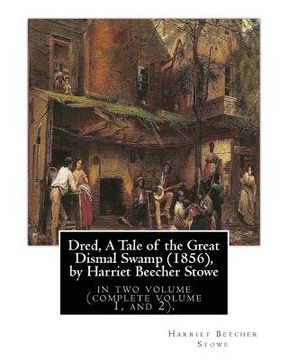Dred, A Tale of the Great Dismal Swamp (1856), by Harriet Beecher Stowe: in two volume (complete volume 1, and 2).
Synopsis "Dred, A Tale of the Great Dismal Swamp (1856), by Harriet Beecher Stowe: in two volume (complete volume 1, and 2)."
Dred: A Tale of the Great Dismal Swamp is the second popular novel from American author Harriet Beecher Stowe. It was first published in two volumes by Phillips, Sampson and Company in 1856. Although it enjoyed better initial sales than her previous, and more famous, novel Uncle Tom's Cabin, it was ultimately less popular. Dred was of a more documentary nature than Uncle Tom's Cabin and thus lacked a character like Uncle Tom to evoke strong emotion from readers.Dred is the story of Nina Gordon, an impetuous young heiress to a large southern plantation, whose land is rapidly becoming worthless. It is run competently by one of Nina's slaves, Harry, who endures a murderous rivalry with Nina's brother Tom Gordon, a drunken, cruel slaveowner. Nina is a flighty young girl, and maintains several suitors, before finally settling down with a man named Clayton. Clayton is socially and religiously liberal, and very idealistic, and has a down-to-earth perpetual-virgin sister, Anne. In addition to Harry (who, as well as being the administrator of Nina's estate, is secretly also her and Tom's half-brother), the slave characters include the devoutly Christian Milly (actually the property of Nina's Aunt Nesbit), and Tomtit, a joker-type character. There is also a family of poor whites, who have but a single, devoted slave, Old Tiff. Dred, the titular character, is one of the Great Dismal Swamp maroons, escaped slaves living in the Great Dismal Swamp, preaching angry and violent retribution for the evils of slavery and rescuing escapees from the dog of the slavecatchers.The response to Stowe's first work greatly impacted her second anti-slavery novel. Uncle Tom's Cabin drew criticism from abolitionists and African-American authors for the passive martyrdom of Uncle Tom and endorsement of colonization as the solution to slavery. Dred, by contrast, introduces a black revolutionary character who is presented as an heir to the American revolution rather than a problem to be expatriated. Dred can thus be placed within an African-American literary tradition as well as a political revision of the sentimental novel (see David Walker's Appeal (1829) and Frederick Douglass's The Heroic Slave (1852)). One often-overlooked subplot involves Judge Clayton, who issues a proslavery opinion that absolves the man who attacked Cora's slave Milly of liability. This judge was constrained by the law from providing relief; this fit with Stowe's belief that law and judges-and religious leaders, too-could not be expected to help end slavery. It was humane sentiments rather than the rule of law that would be the lever for antislavery action. The novel is also interesting in the historical context of runaway slave communities surviving for a long time in swamp areas. Swamps were places where runaway slaves could hide, and therefore became a taboo subject, particularly in the south. The best hiding places were found on high ground in swampy areas. The novel also contains detailed descriptions of the wetlands in the "Dismal Swamp" and is therefore also interesting in the context of the way in which African Americans relate to the natural environment.Harriet Elisabeth Beecher Stowe ( June 14, 1811 - July 1, 1896) was an American abolitionist and author. She came from a famous religious family and is best known for her novel Uncle Tom's Cabin (1852). It depicts the harsh life for African Americans under slavery. It reached millions as a novel and play, and became influential in the United States and Great Britain. It energized anti-slavery forces in the American North, while provoking widespread anger in the South. She wrote 30 books, including novels, three travel memoirs, and collections of articles and letters. She was influential for both her writings and her public stands on social issues of the day.

